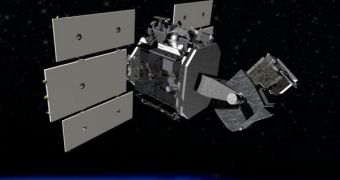Officials with the United States Air Force (USAF) announce the successful launch and deployment to orbit of the first Space-Based Space Surveillance (SBSS) satellite.
The point of the demonstrator instrument is to show whether keeping an eye on the large quantities of space debris that surround the planet today is possible from space.
The satellite has impressive tracking abilities, that researchers say could come very well in hand when an orbital emergency develops.
This is also a very important component of the Space Surveillance Network (SSN), an ever-expanding military network that is aimed at keeping an eye on US national security risks that may come from space.
The new satellite was launched at 9:41 pm PDT late Saturday, September 25 (0441 GMT September 26), from the Vandenberg Air Force Base (VAFB), in California.
SBSS was delivered to orbit by a Minotaur 4 rocket. The launch was delayed from its original date by various glitches in the delivery system, but everything was fixed in the end.
“This satellite is going to revolutionize the way we track objects in space by not being constrained by weather, the atmosphere or the time of day,” said in a briefing Colonel J.R. Jordan.
He is the vice-commander of the Space Superiority Systems Wing with the USAF Space and Missile Systems Center, Space reports.
“This capability will be essential to our space situational awareness architecture for the near future and beyond,” he added, saying that the SBSS program costs about $858 million.
“SBSS will greatly enhance our existing space situational awareness capability, a capability vital to protecting our space-based assets,” explained on Saturday Col. Richard Boltz.
He is the commander of the 30th Space Wing at the VAFB. The launch facility at the USAF installation handled three launches in the the past eight days.
One of the main innovations that make the SBSS so important is its ability to quickly turn its cameras on its targets, without needing readjustments and orbital changes.
An agile, two-axis gimbal is outfitted with video sensors, and mission controllers can quickly move the stuff around, so as to capture as much data on space debris as possible.
“That gimbal is able to quickly move to detect events in space. The agility contributes significantly to the advantages of the SBSS to provide space situational awareness,” adds the director of the Boeing Advanced Space and Intelligence Systems, Todd Citron.
The Boeing Company is the main contractor for the first SBSS satellite. The team that built the spacecraft also includes Ball Aerospace & Technologies Corp.

 14 DAY TRIAL //
14 DAY TRIAL //